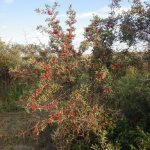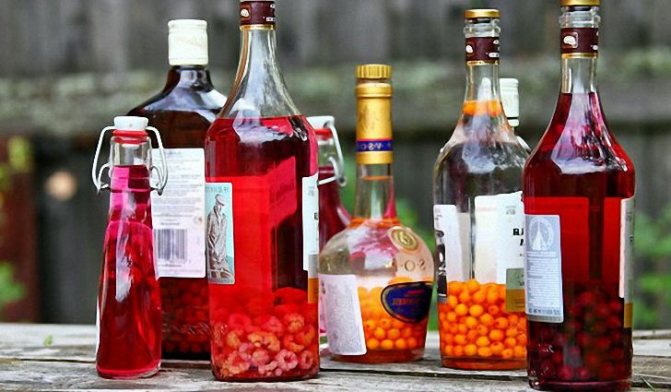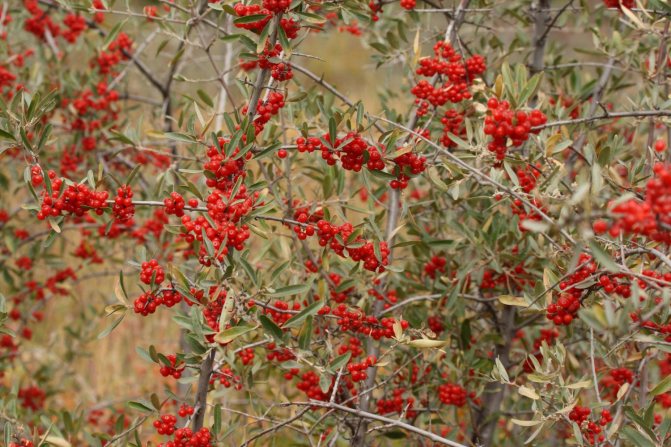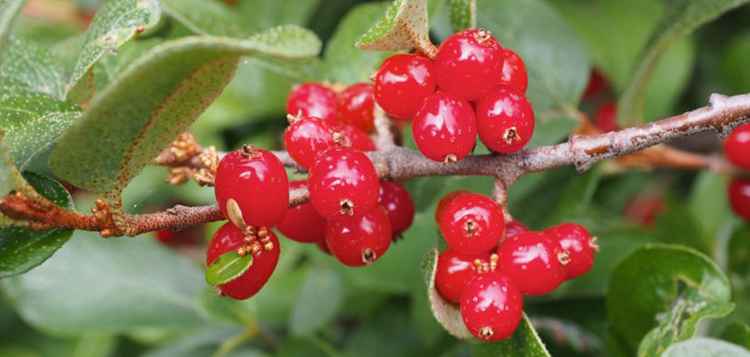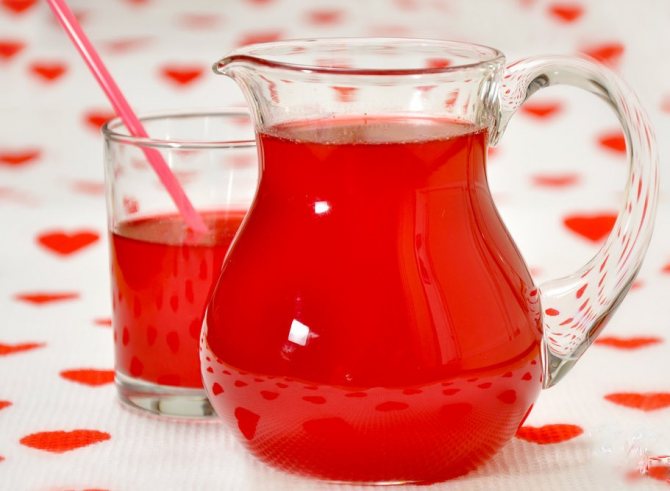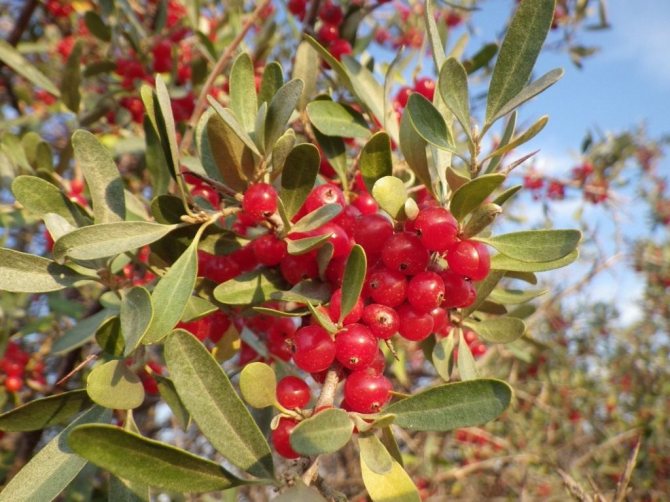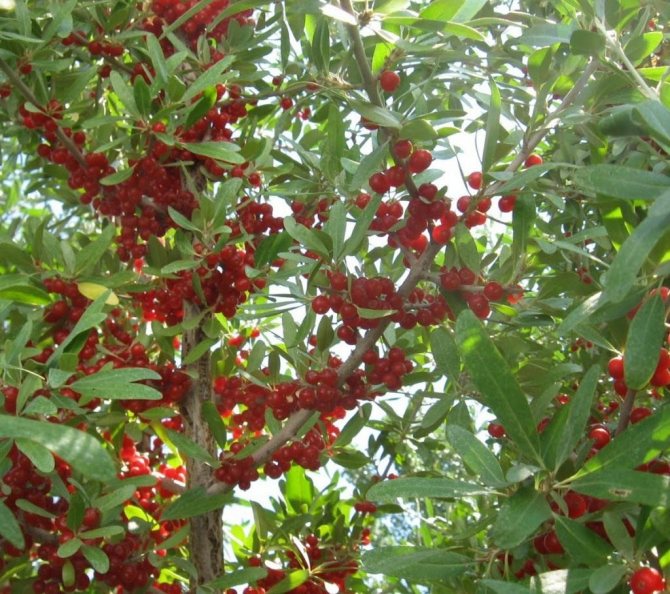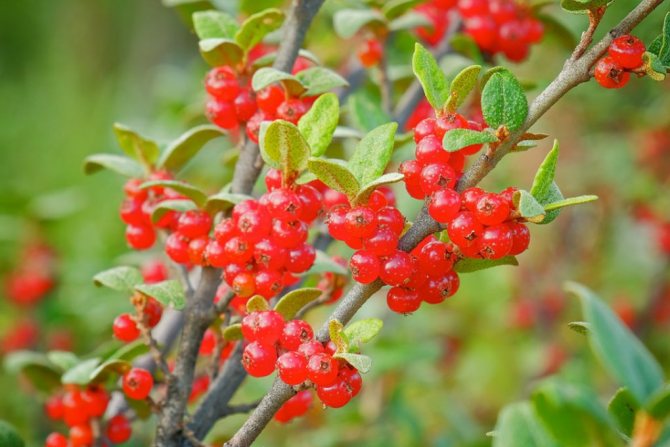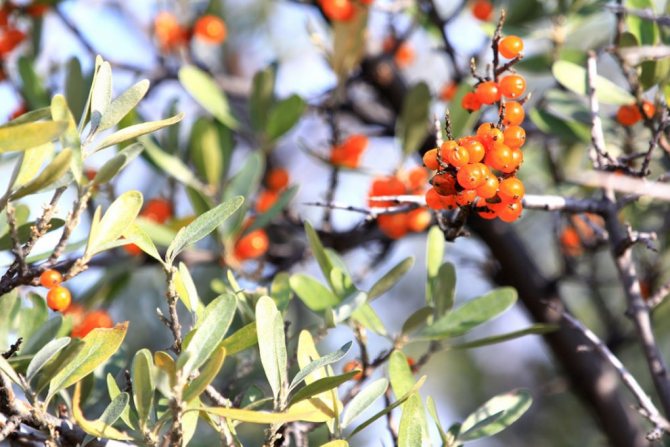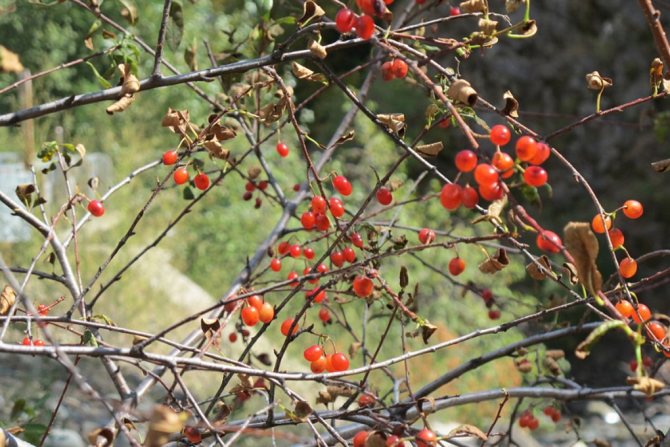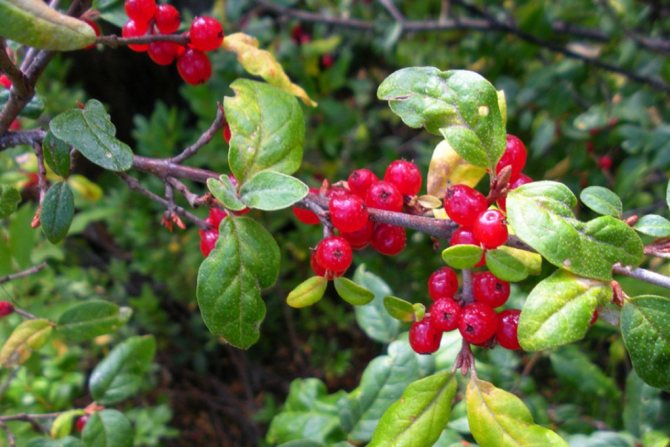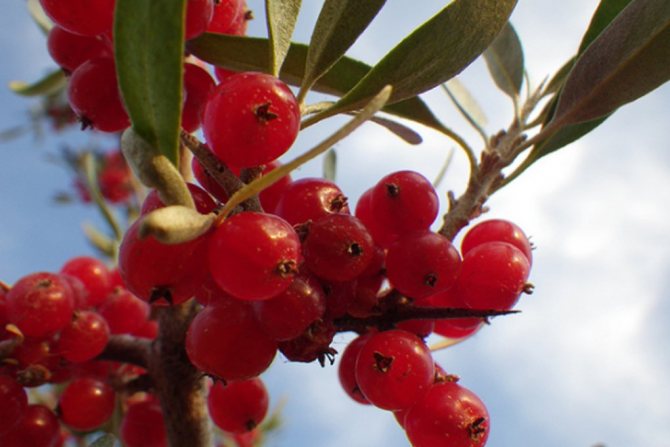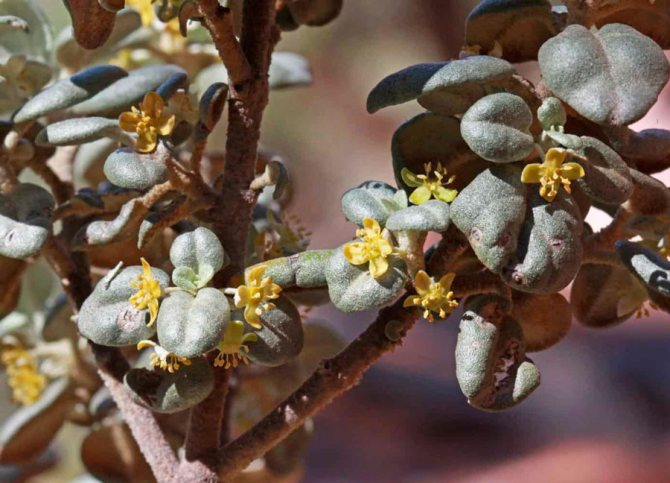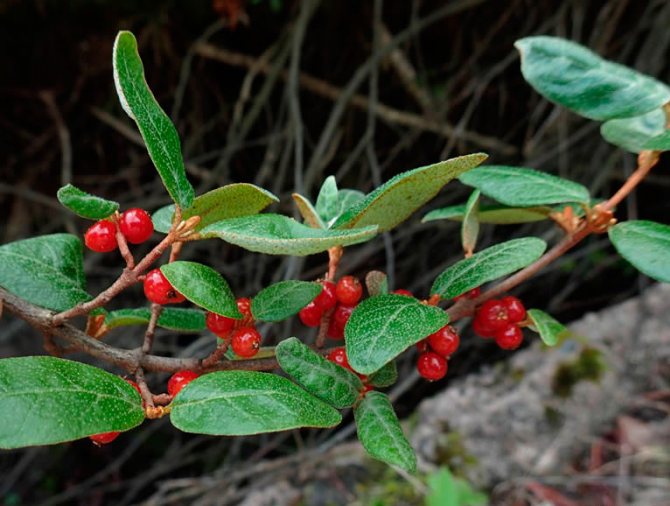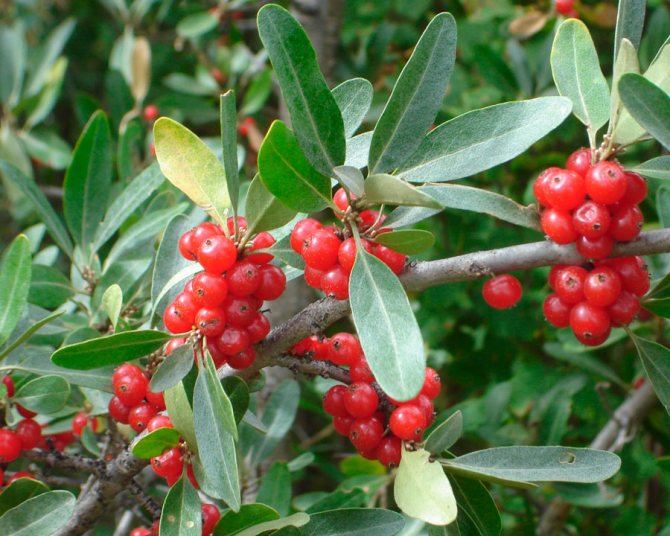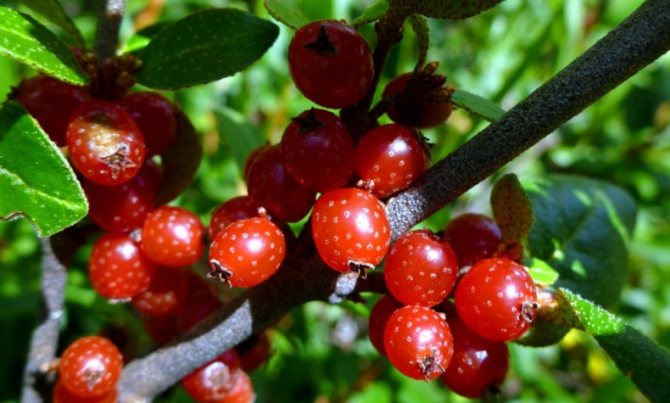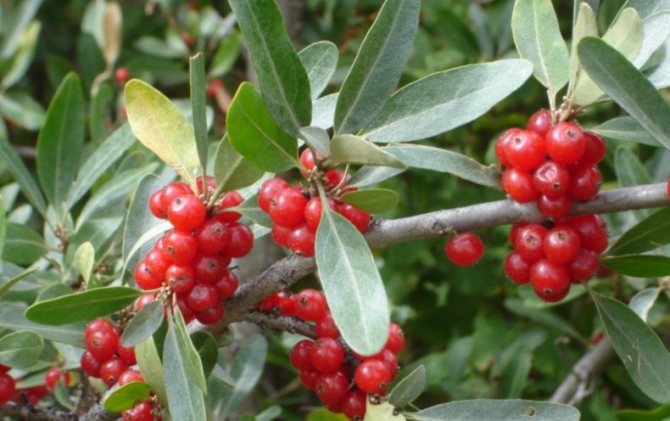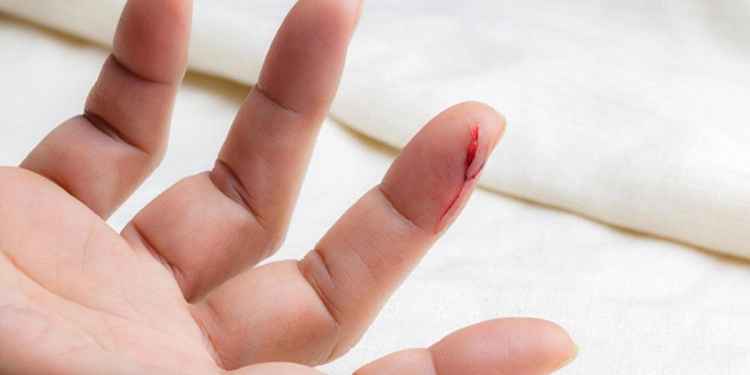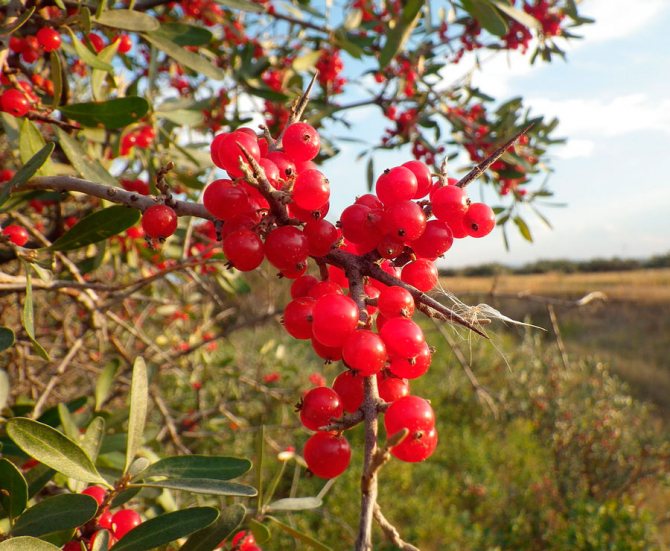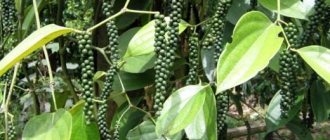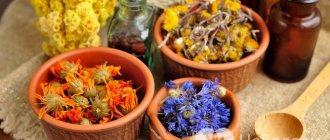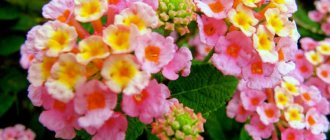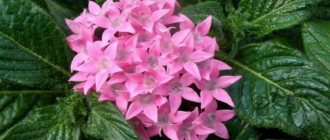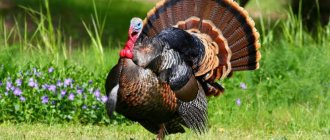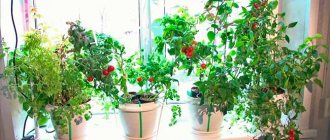General description of berry culture
A voluminous shrub with thorny shoots, up to 6 m high, with dense, hairy foliage of rich green color and silvery stems. The green and silver ensemble is wonderfully complemented by glossy red berries that coquettishly peek out from under the leaves. Much shorter in growth - only up to 1.5 m - canadian shepherdia, which has smooth brown stems and is distinguished by a high degree of winter hardiness.

Shepherdia silvery - voluminous shrub with thorny shoots
Shepherdia silvery belongs to dioecious plants, therefore, "male" and "female" trees are needed for pollination.
Flowering period and ripening time
Shepherdia blooms with small yellowish flowers, which gather in spikelets in the "male" trees, and are arranged singly in the "female" trees. The flowering period usually begins in early April and lasts up to 20 days. Ripening occurs in mid-August, but experienced gardeners know that the longer the fruits are on the branches, the sweeter their taste.
Timing of fruiting
The life of the tree can reach 60 years, the shrub bears fruit up to 40-50 years. Flowering and fruiting, depending on the place and growing conditions, occurs 2-3 years after planting. Fruiting is annual, ripe fruits are easily separated from the shoot.
Yield indicators
The first harvest can be in the range of 13-15 kg, increasing every year. As a result, this figure can be 30 kg.


Average crop yield - 30 kg
Winter hardiness
In addition to resistance to diseases and pests, the shrub has a high degree of frost resistance. This makes it possible to grow the plant in the northern regions, in Siberia and the Urals. She is not afraid of return frosts in winter, which are destructive for many berry crops.
The most common types of this shrub
The shepherdia clan has only three varieties, but they all differ from each other.
- Silver shepherdia is called so because it has a silvery fluff on leaves on both sides and on young shoots. This shrub is quite thorny, reaching a length of more than six meters. Throws flowers in early April. The male species has flowers that resemble small spikelets. In the female plant, flowers grow one at a time. The peak of her decorative effect is in the fall. At the beginning of autumn, fruits appear - berries of red or yellow-orange color. Lovers of exotic liked the decorative variety Goldeneye. When the fruits ripen on it, they will be bright yellow in color.
- Canadian Shepherdia is very similar in appearance to a tree with a spreading crown. The branches are brown, the leaves are smooth, dark green above, and have silvery villi and yellow scales below. Flowering begins in April, and the flowers are yellow-green. By mid-September, ripe fruits of a dark red color and oblong shape, up to 8 mm long, are observed on the bush.
- The round-leaved shepherdia resembles a rather tall and spreading shrub. Its branches are intertwined and covered with dark green rounded leaves. There are numerous warty growths in the leaf plate. It is this species that blooms and bears fruit very profusely.It happens that branches, heavy from berries, lean towards the ground itself. This type of shepherdia is found only in the state of Colorado and very rarely in other territories.
Advantages and disadvantages
Culture has a number of advantages, among which there are useful properties for human health:
- unpretentiousness to growing conditions and care;
- high degree of frost resistance;
- lack of susceptibility to fungal infections and pest attacks;
- ease of reproduction;
- good transportability;
- medicinal properties: it copes well with colds and helps to overcome viral infections, has an excellent effect on general well-being and strengthens the immune system, normalizes the work of the digestive and cardiac systems, strengthens blood vessels and capillaries, prevents atherosclerosis;
- the possibility of using in cooking.
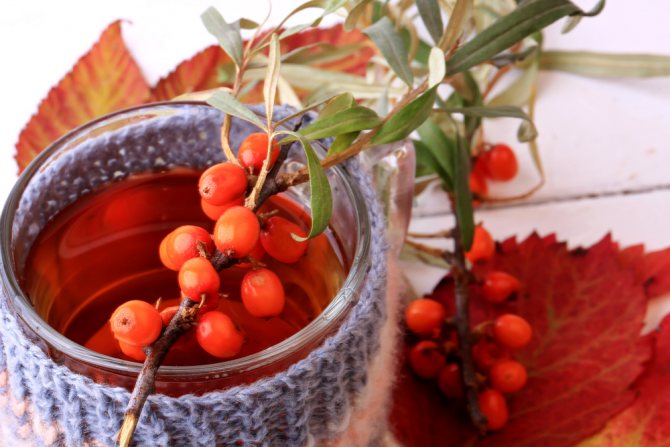

Ripe berries are used in cooking and folk medicine
Landing rules
The tree does not need special growing conditions, it feels great both on rocky and steep areas. Strong and branched root system perfectly absorbs and retains moisture.
Recommended timing
Like most trees, shepherdia is planted in the spring, after the soil has thawed and warmed up. In most regions, this time falls in early April. But this must be done before the kidneys wake up. This is especially true in the Urals and Siberia.
Site selection and soil preparation
For planting, it is recommended to choose a sunny, spacious place. Space is a must for an extensive root system. Lowlands and swampy soils are not suitable for shrubs - fog and stagnant water can have a detrimental effect on the roots and provoke their decay.
Any loamy and sandy loam soils are suitable for cultivation. Shepherdia bears fruit equally well in any of them.
If the groundwater is located quite close to the surface, a mulch layer is indispensable. The plant can independently enrich the soil with nitrogen due to the presence of nitrogen balls on the roots.
Selection and preparation of seedlings
A seedling aged from one to one and a half years is best suited for planting. They must have a developed root system.
Before planting, it is necessary to inspect the roots for damage: dry and damaged roots must be carefully cut off and the cut points must be treated with activated or charcoal.
Author's advice
Healthy root shoots are cut off by a few centimeters without affecting the nodules, the shoots are shortened by ⅓. Then the seedling is placed in a solution of a growth stimulant or potassium permanganate.
Algorithm and scheme of landing
The planting hole should be at least half a meter in diameter and in depth. A drainage layer and a layer of fertile soil are poured into the pit. Then the seedling is placed and the roots are straightened. Sprinkling the plant with soil, it is periodically shaken so that the soil remains light and airy, but lies in a dense layer.
For ornamental varieties, half a meter of distance between seedlings is enough. Large shrubs should be planted at a distance of at least 2 m. After planting, the seedling is watered in the zone of the trunk circle. Then mulch with peat or humus.
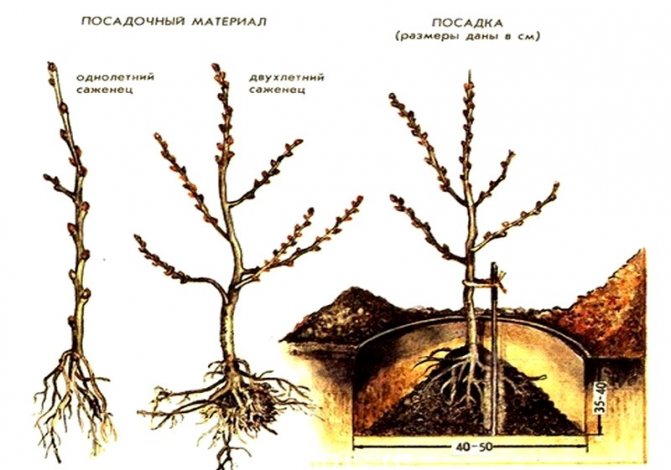

Planting scheme for shepherdia silver
Beneficial features
Shepherdia berries lead in the amount of ascorbic acid. In addition to her, the fruits contain:
- tannins;
- vitamins A, P, E;
- pectin;
- organic acids.
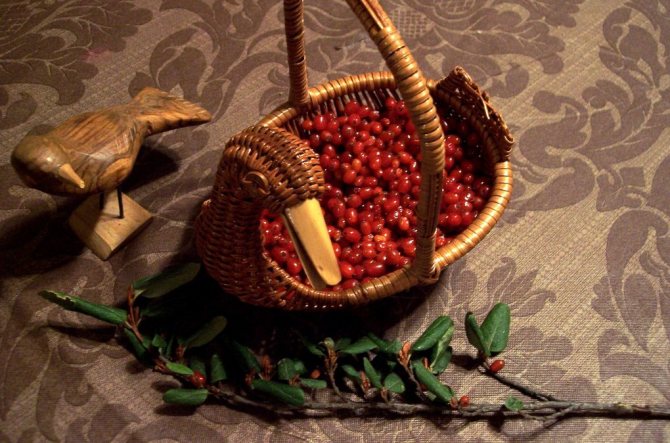

The use of Shepherdia fruits helps to strengthen the immune system, take care of the state of blood vessels, and normalize blood pressure. Berries can be eaten raw, made into alcoholic tinctures, and all sorts of sauces, jams and preserves can be prepared. They are more a food product than a medicine, therefore they have no contraindications. Caution should be exercised only in people prone to allergic reactions.
In terms of vitamin C content, Shepherdia overtakes even its close relative - sea buckthorn. In this article, everything about the benefits and dangers of shepherdia silvery, the medicinal properties of the plant, the available contraindications.
Follow-up care of the culture
According to gardeners' reviews, Shepherdia does not need special care, a minimum of agrotechnical measures is enough.
Watering and fertilizing
A shrub rarely needs watering, usually it receives enough moisture from precipitation. However, in hot dry periods and in regions with prolonged periods of heat and drought, the soil around is systematically loosened and watered.
The first feeding is carried out even during planting, applying organic fertilizers: diluted manure, humus or compost. Then you can add mineral complexes enriched with calcium and magnesium once a year.
Shrub pruning
One of the most important maintenance aspects is pruning. Sanitary pruning is carried out annually in order to remove damaged and dry shoots and thinning the crown. Incorrectly growing shoots are also removed, which interfere with the growth of fruiting shoots and impede the access of light and air to them.
Also, pruning is performed in order to form the crown. And it is easier to care for a short plant. For rejuvenation, the branches are pruned by ⅓ every seven years. If the crown droops under the weight of the shoots, then it is necessary to cut off all branches, except for those growing vertically.
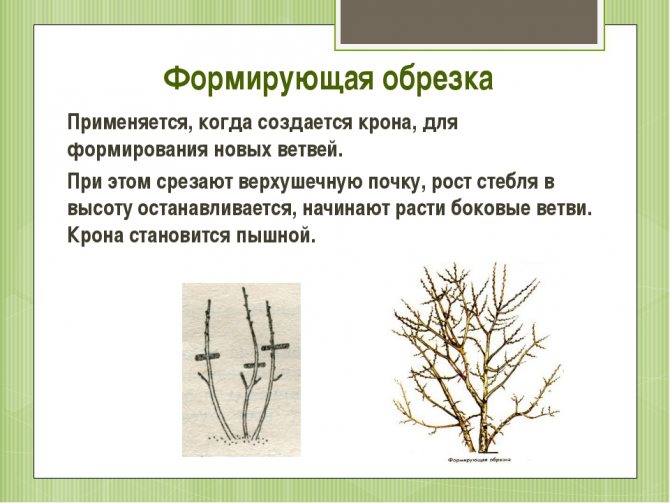

Formative


Rejuvenating


Sanitary
Preparing for winter
Since shepherdia silver can withstand frosts down to -45 ° C, only young immature plants need preparatory measures. They are insulated with a special covering material or mulched with peat. Mature plants only need shelter at temperatures below 45 ° C.
Diseases and pests
The shrub rarely suffers from plant diseases, therefore it does not need preventive treatment with fungicides. And no pests of Shepherdia are terrible. It is the ability to do without the use of insecticides and fungicides that allows you to grow an environmentally friendly crop.
Pharmacological properties
The fruits of shepherdia silvery have many pronounced beneficial properties. The leukoanthocyanins and catechins contained in them help to increase the strength and elasticity of the walls of veins, arteries and arterioles, and also reduce their fragility. Carotene, which is present in excess in fruits, helps to improve the functioning of the visual analyzer and prevents the development of many ophthalmic diseases.
In addition, carotene is the initial substance that our body needs for the synthesis of vitamin A, and therefore the use of red sea buckthorn has a positive effect on the condition of the skin.
Vitamin C, which is part of the berry in large quantities, helps to increase and strengthen the immune function of the body, helps to better cope with the processes of resuming normal work after suffering various acute respiratory viral infections and influenza.
How does shepherdia silvery reproduce?
Another advantage of the red-fruited sea buckthorn is the possibility of its reproduction in various ways.
Seeds
You can get the planting material yourself. To do this, it is enough to grind the berries to a state of gruel, dry and extract the seeds. But they need to be planted in the same year, as they quickly lose their ability to germinate.
Seeds are grown in greenhouse conditions, but there is no need to heat the greenhouse. The seeds are planted to a depth of several centimeters. Seedlings appear by the end of April, and by the beginning of autumn, when the seedlings reach 15 cm, they can be transplanted to the chosen place in the open ground.
The seedling will begin to bear fruit in about 5 years.
Root shoots
Many basal processes are formed from the shrub. For reproduction, select shoots located at a distance of 1.5 or 2 m from the bush.The best option is two-year-old shoots. The soil is dug up, a healthy, strong shoot of the main bush is taken out and transplanted to a new place.


Fruit and berry shrubs are propagated by root shoots
Cuttings
The most popular method that allows you to immediately identify the "male" and "female" plant. The stalk must have several fertile buds. The length of the seedling is at least 8 cm. First, the cutting is placed in a growth stimulant solution, then planted in sandy-peat soil, deepening by 3-4 cm. When the cutting has strong roots, it can be transplanted to a permanent place.
Reproduction methods
Successful reproduction of silver shepherdia is possible, like in other plants, by seeds and vegetatively. The main thing is to approach this matter responsibly and do everything correctly.
Seed propagation is the most laborious and time consuming way. In this case, the "bull berry" will please you with the first color and fruits not soon - in 4-5 years. Despite this, seeds are an effective type of reproduction, and they deserve a right to exist. The algorithm is as follows:
- in October / November in the open field, pits are made up to 3 centimeters deep;
- seeds are laid in these recesses and sprinkled with soil;
- for the cold period, the landing site is covered with snow.
The first shoots usually appear in April, possibly by mid-May. By autumn, the height of the bushes will be up to 20 centimeters. A transplant to a permanent habitat should be done next spring.
Vegetative ways
There are several vegetative breeding methods for the American sea buckthorn. This is the detachment of root processes and, of course, cuttings.
The first type is that in the third year of the shepherdia's life, root offspring appear, located at a distance of 2 meters from the main shrub, and it can be separated from the mother tree. Such still small plants are planted in the same way as ordinary seedlings.
The second species is probably the most popular breeding method and has a significant advantage. The stalk is good because, when choosing it, you can immediately distinguish a male plant from a female one. This is a very significant factor in horticulture.
Propagation by cuttings is done as follows:
- in early spring, green cuttings with 2-4 buds up to 15 centimeters long are chosen;
- carefully cut off these branches;
- put the cuttings in a solution of a biostimulating substance for a day;
- the next day, depressions up to 4 centimeters are made in the sandy-peat soil and cuttings are planted there;
- it is better to insulate the soil with a film on top;
- by mid-autumn, young shrubs will already be well developed and ready for transplantation to a permanent place.
Shepherdia silver in landscape design
Bright colors, an abundance of foliage and berries, unpretentious care made the plant a favorite of designers and gardeners. Low-growing shrubs are great for creating hedges and park oases.
Large specimens are perfect as decoration and shading of the coastal zone or the area of the reservoir. If you add an ensemble of climbing rose bushes, then a light shade of Provence will add charm to the overall picture.
The advantages of Shepherdia are worth planting a couple of shrubs in the country or in a personal plot. In spring and summer, the appearance will delight the eye, and the tincture and wonderful sauces for meat will delight the taste buds in winter.
Chemical composition
Shepherdia is the best natural source of vitamins and minerals. In terms of the amount of vitamin C included in the composition, it is able to compete with many citrus fruits. And as for the catechins and oil substances that are part of, then they overtake the world recognized leader in these parameters - sea buckthorn. The main chemical composition of the berry can be characterized as follows:
- various sugars;
- many organic acids;
- ascorbic acid;
- substances with tanning properties;
- pectin;
- carotene;
- vitamins C and P;
- lipokines.
Read also: Radish: benefits and harms, calorie content, application


Cleaning
The fruits are harvested fully ripe in September. When collected, they are easily separated from the branch; they can be collected by shaking them off onto a film spread out under the crown. Harvesting is complicated by the numerous thorns on the branches.
Rate the article:
- 5
- 4
- 3
- 2
- 1
(0 votes, average: 0 out of 5)
Share with your friends!
Growing conditions
Shepherdia silvery good suitable for European climate, therefore, you can safely choose it as a fruitful and decorative inhabitant of a summer cottage. It is frost-resistant, resistant to drought, plant diseases and undemanding to care for, gets along well with other trees, herbs, flowers.
Location and lighting
In general, the plant will quickly adapt to the planting site. It is worth considering that the "bovine berry" adores the sunny side. If the American sea buckthorn receives a sufficient amount of light and heat, it will surely "thank" you, as this will contribute to a bright, abundant flowering, and subsequently the harvest will be better and sweeter.
Strong winds and even a draft will not affect the tree in any way. In addition, if it is reasonable to plant shrubs on the site, it will protect the estate from gusts of wind, making the place quiet, comfortable and secluded.


Read also: Epin for tomato seedlings: instructions for use, how to breed for spraying
Soil requirements
For proper cultivation and effective further care of Shepherdia, it is worth taking care of a suitable soil content. The plant can live on different soil compositions: stony, sandy and even saline soils. The soil must be loose so that the roots can be enriched with oxygen and other nutrients. It is desirable that the land is fertile, so the chances of growing a beautiful tree are much higher.

